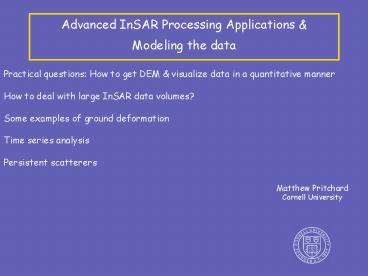Advanced InSAR Processing Applications - PowerPoint PPT Presentation
1 / 16
Title:
Advanced InSAR Processing Applications
Description:
Practical questions: How to get DEM & visualize data in a ... Long Valley Caldera, Hooper et al. 2004. Select pixels with stable scattering behavior over time ... – PowerPoint PPT presentation
Number of Views:677
Avg rating:3.0/5.0
Title: Advanced InSAR Processing Applications
1
- Advanced InSAR Processing Applications
- Modeling the data
Practical questions How to get DEM visualize
data in a quantitative manner How to deal with
large InSAR data volumes? Some examples of
ground deformation Time series
analysis Persistent scatterers
Matthew Pritchard Cornell University
2
- Visualizing the data preparing for modeling
At roipac.org Perl script unw2png.pl will
convert geocoded interferogram to Google Earth
kml file and png Various GMT scripts Example
Matlab script for loading data (by the end of the
week) For GIS software, use .rsc file to create
metadata file and perhaps rmg2mag_phs to make a
single binary file
3
- Access to topographic data
Source I use most often SRTM 1 degree tiles
either at 3 arcsec (90m) or 1 arcsec for U.S. (30
m) Also available from seamless USGS server.
Can access available Lidar and NED data for
U.S. ASTER GDEM -- posted at 1 arcsecond, but
various analysis indicates it is closer to 3
arcsec Format needs to be I2 (16 bit) binary
file with no header Need to create .rsc file
with upper left coordinates, of rows and
columns, and pixel spacing
4
Compare resampling methods
The problem reduce 106-107points to 102-103
Compare 1. Data resolution matrix
method (Lohman Simons, 2005) 2. Curvature
based (Simons et al., 2002) 3. Quadtree
(Jonsson et al., 2002) 4. Uniform Potential
downsides 1. Need to specify a model 2 3
Sensitive to noisy data 4. Need too many points
to get near model detail
From Lohman Simons, 2005
5
New techniques Time series of interferograms
Data available in southern California From Yuri
Fialko
6
New techniques Time series of interferograms
Possible pairs with Perpendicular baseline lt 200
m From Yuri Fialko
7
- Strategies for combining multiple interferograms
Prerequisite Need to co-register interferograms
either in radar or geographic coordinate. You can
do this in ROI_PAC 3.0.1 using process_2pass_maste
r.pl by settin the Do_sim flag in the .proc
file A time-invariant view is stacking Just
take co-registered interferograms and add them
together -- divide by the total time interval to
get a rate A time-variable view is called
time-series including methods called SBAS,
PSInSAR, etc.
8
New techniques Time series of interferograms
Actual pairs made -- reduce influence of scenes
with severe atmospheric noise From Yuri Fialko
9
New techniques Time series of interferograms
The Basic Idea
Interferogram Number
Date
10
New techniques Time series of interferograms
The Basic Idea
Interferogram Number
Date
A stack of interferograms provides multiple
constraints on a given time interval
11
New techniques Time series of interferograms
The Basic Idea
Interferogram Number
Date
Goal Solve for the deformation history that, in
a least-squared sense, fits the set of
observations (i.e., interferograms), Many
different methods (e.g., Lundgren et al. (2001),
Schmidt Burgmann, 2003), but SBAS (Berardino et
al. (2002)) is perhaps most common one
12
Persistent scatterers (PS or PSInSAR)
- Select pixels with stable scattering behavior
over time - Only focus on good pixels
- InSAR
- Spatial coherence _at_ 1 time
- Need neighborhoods of good pts
- PS
- Coherence _at_ 1 point
- Need gt 15-20 scenes
- Added bonus
- DEM errors!
Long Valley Caldera, Hooper et al. 2004
From Rowena Lohman
13
StaMPS method (Hooper et al., 2004)
Example Imperial Valley, CA
From Rowena Lohman
14
Review Will InSAR work for you?
- What is the local rate of deformation?
- Sensitivity of single igram 1cm
- How many years to get signal this big and will it
be overcome by noise? - Can you stack several igrams together?
- What is the scale of deformation?
- Pixel size 10m, but generally need to average
many together - Image size is 100 km, but if too broad worry
about precision of orbits - What is the local noise?
- How much vegetation/precipitation/water
vapor/human cultivation? - Can you only make igrams with data from the same
seasons? - Can you get L-band data and find persistent
scatterers? - What data is available?
- Is there data from multiple satellites and/or
imaging geometries?
15
Review How to set up InSAR capability?
- 1) Establish access to data
- Main sources see next slide
- How? Can be purchased commercially. Lower
cost/no-cost data available with restrictions.
In Europe, through ESA. In U.S., through ASF and
UNAVCO. Some foreign access is allowed to UNAVCO - Can useful interferograms be made with available
data? Worry about ground conditions, radar
wavelength, frequency of observations,
perpendicular baseline, availability of advanced
processing techniques - 2) Purchase/Install software to process and
visualize data - Open source ROI_PAC, DORIS, RAT and IDIOT (TU
Berlin) - Commercial Gamma, TR Europa, Vexcel/Atlantis,
DIAPASON, SARscape - 3) Download/create DEM (SRTM is only /- 60
degrees latitude, but ASTER G-DEM in 2009) - 4) Download precise orbital information
instrument files (Only ERS Envisat) - 5) Interpret results, create stacks, time series,
persistent scatterers. May need to
buy/downoad/create new software - 6) Publish new discoveries and software tools!
16
For More Information
- Good overview of classical space based geodesy
(but no InSAR) John Wahrs online textbook
http//samizdat.mines.edu/geodesy - Introductions to InSAR
- 2 page overview from Physics Today
http//www.geo.cornell.edu/eas/PeoplePlaces/Facult
y/matt/vol59no7p68_69.pdf - Overviews of applications Massonnet Feigl,
Rev. Geophys., 1998 Burgmann et al., AREPS,
2000. - More advanced InSAR
- The definitive SAR book Curlander Mcdonough,
1990 - More technical reviews Rosen et al., IEEE 2000
Hanssens Radar Interferometry book, 2001 Simons
Rosen, Treatise on Geophysics, 2007 - Time series analysis Berardino et al., IEEE,
2002 Schmidt Burgmann, JGR, 2003 - Persistent scatterers Ferretti IEEE, 2001
Hooper et al., GRL, 2004 Kampes Persistent
Scatterers book, 2006










![Earthquake Prediction Research [EPR] PowerPoint PPT Presentation](https://s3.amazonaws.com/images.powershow.com/P1252428560pfrIQ.th0.jpg?_=20140201108)




















